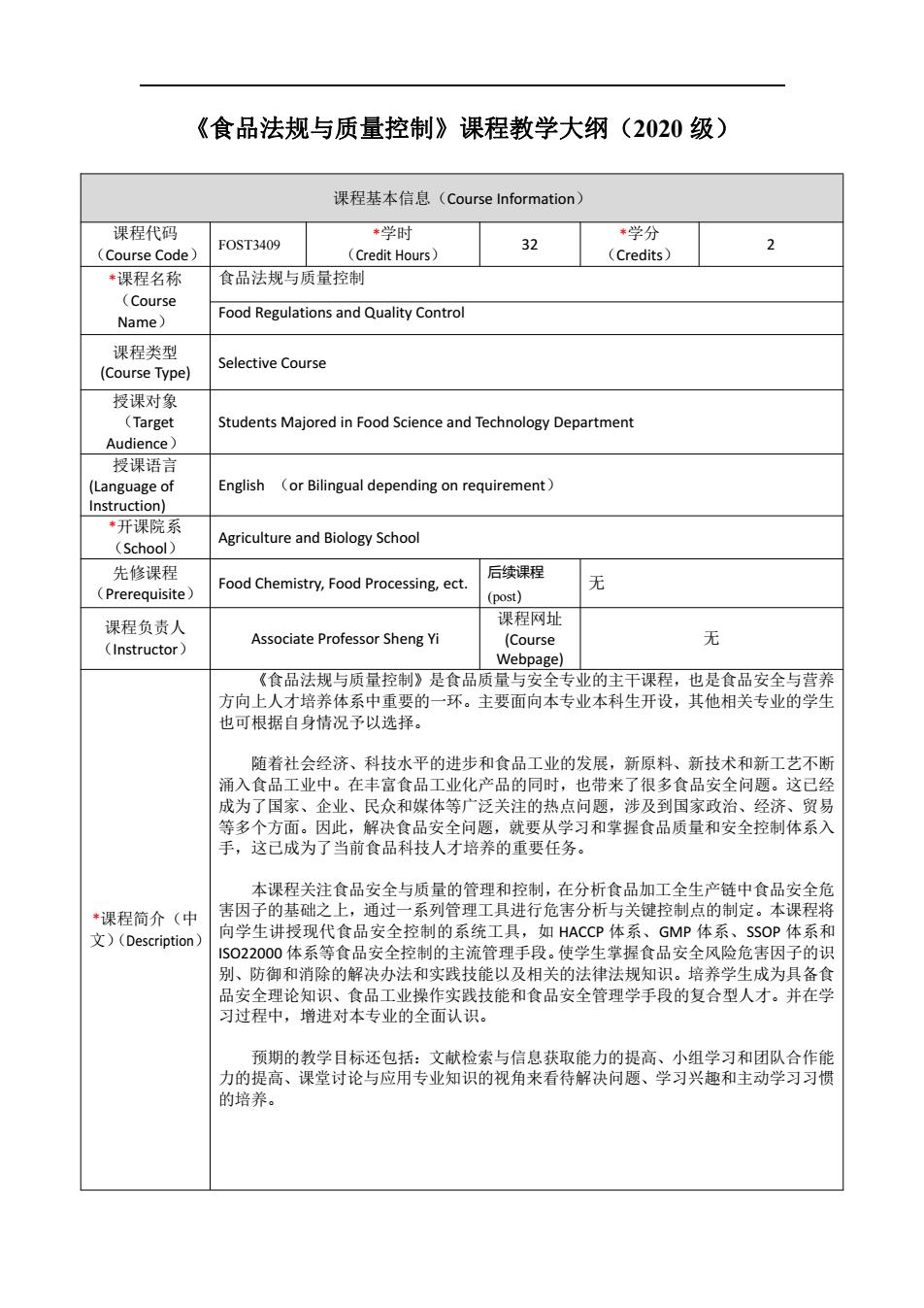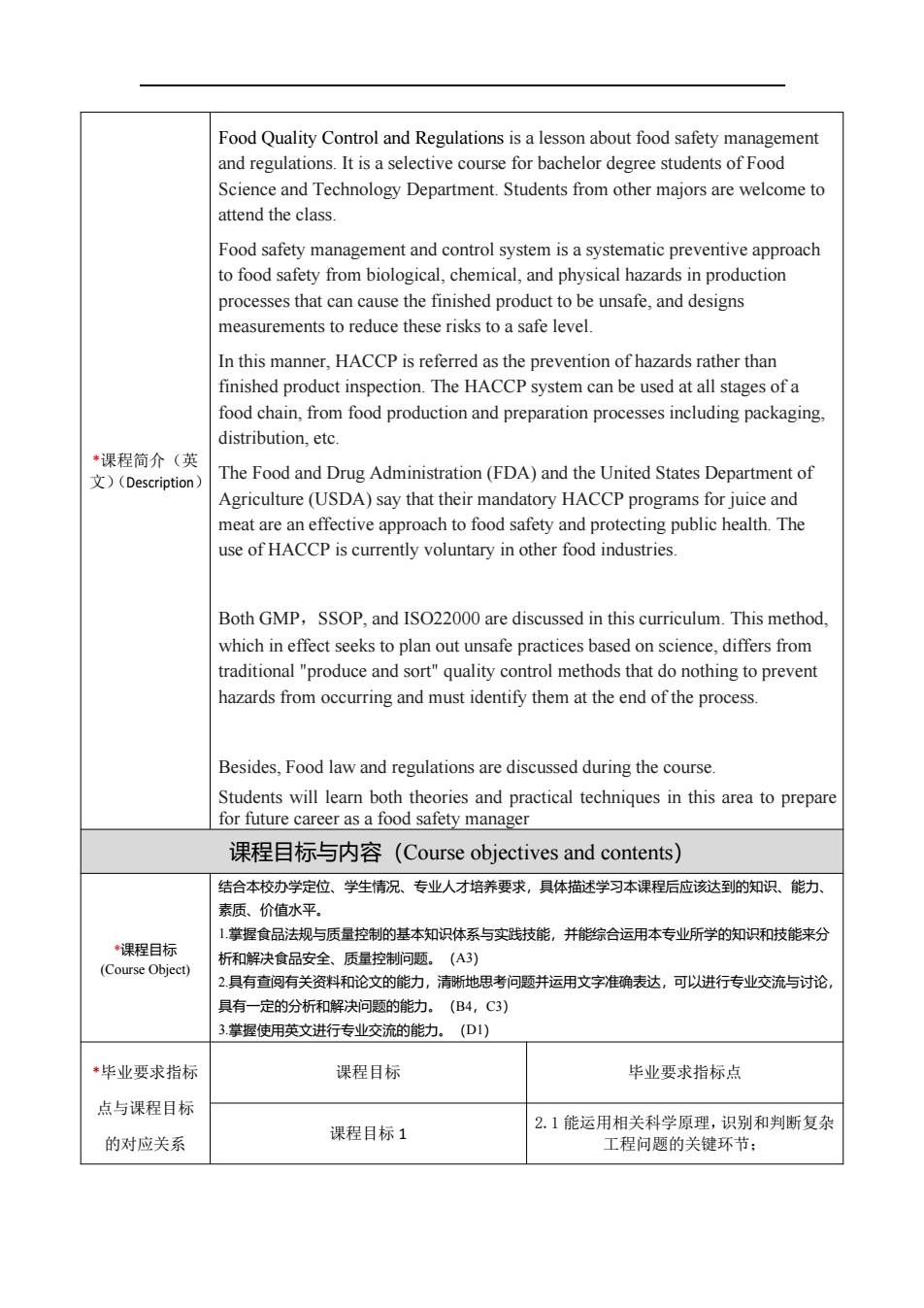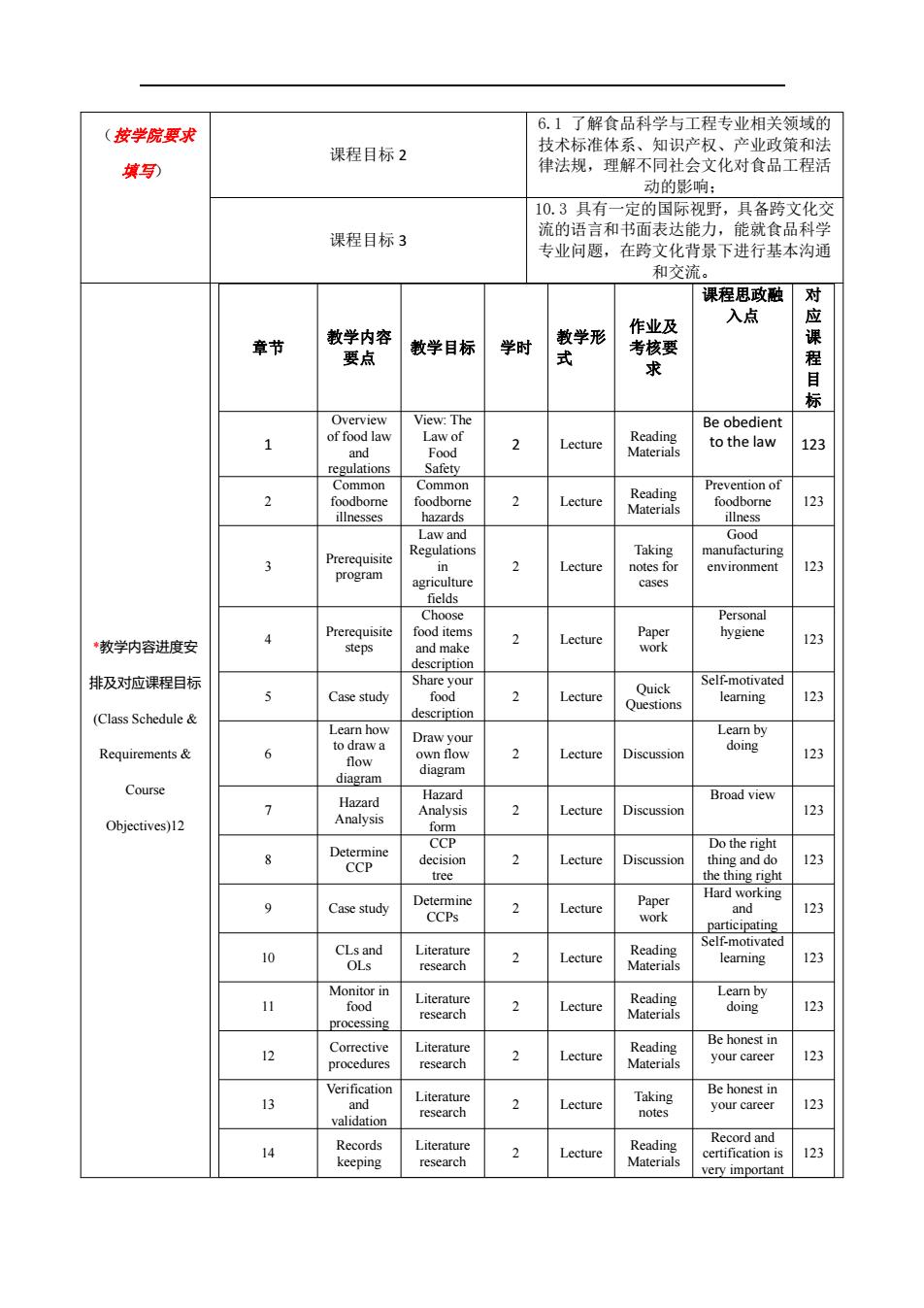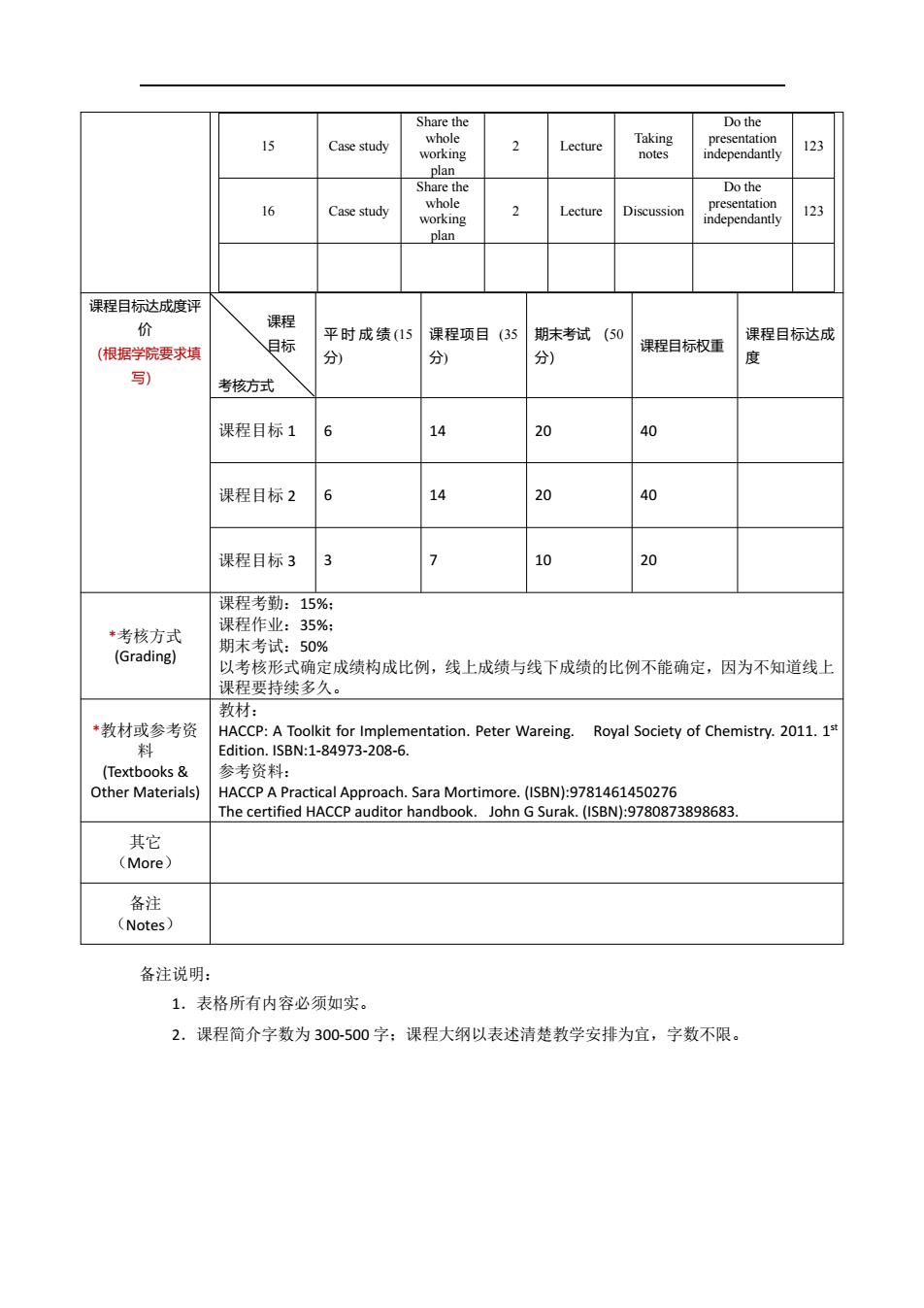
《食品法规与质量控制》课程教学大纲(2020级) 课程基本信息(Course Information) 课程代码 *学时 *学分 F0ST3409 32 (Course Code) 2 (Credit Hours) (Credits】 *课程名称 食品法规与质量控制 (Course Name) Food Regulations and Quality Control 课程类型 (Course Type) SelectiveCourse 授课对象 (Target Students Maiored in Food Science and Technology Department Audience 授课语 (Language o English (or Bilingual depending on requirement) 开课院系 (School) Agriculture and Biology School Food Chemistry,Food Processing,ect. 后续课程 课程负责人 Instruc or Associate Professor Sheng Yi 无 《食品法规与质量控制》是食品质量与安全专业的主干课程,也是食品安全与营养 方向上人才培养体系中重要的一环。主要面向本专业本科生开设,其他相关专业的学生 也可根据自身情况予以选择。 科技水平的进 和食品工业的发展 新原料 业 ,也带米 新技术和 江 不 品的同 等多个力面为出前食到特才的以学习 从学习和掌握食 本课程关注食品安全与质量的管理和控制,在分析食品加工全生产链中食品安全危 课程简介(中 害因子的基础之上,通过一系列管理工具进行危害分析与关键控制点的制定。本课程将 文)(Description 向学生讲授现代食品安全控制的系统工具,如HACCP体系、GMP体系,SSOP体系和 1S022000体系等食品安全控制的主 流管理手段。使学生 它风险書因于的 别、防御和消 :的解决办法和实践 习程中,论进对木专业的面 技能和食品安全管理学于段的复合型人井在 的法伴 预期的教学目标还包括:文献检索与信息获取能力的提高、小组学习和团队合作能 力的提高、课堂讨论与应用专业知识的视角来看待解决问题、学习兴趣和主动学习习惯 的培养
《食品法规与质量控制》课程教学大纲(2020 级) 课程基本信息(Course Information) 课程代码 (Course Code) FOST3409 *学时 (Credit Hours) 32 *学分 (Credits) 2 *课程名称 (Course Name) 食品法规与质量控制 Food Regulations and Quality Control 课程类型 (Course Type) Selective Course 授课对象 (Target Audience) Students Majored in Food Science and Technology Department 授课语言 (Language of Instruction) English (or Bilingual depending on requirement) *开课院系 (School) Agriculture and Biology School 先修课程 (Prerequisite) Food Chemistry, Food Processing, ect. 后续课程 (post) 无 课程负责人 (Instructor) Associate Professor Sheng Yi 课程网址 (Course Webpage) 无 *课程简介(中 文)(Description) 《食品法规与质量控制》是食品质量与安全专业的主干课程,也是食品安全与营养 方向上人才培养体系中重要的一环。主要面向本专业本科生开设,其他相关专业的学生 也可根据自身情况予以选择。 随着社会经济、科技水平的进步和食品工业的发展,新原料、新技术和新工艺不断 涌入食品工业中。在丰富食品工业化产品的同时,也带来了很多食品安全问题。这已经 成为了国家、企业、民众和媒体等广泛关注的热点问题,涉及到国家政治、经济、贸易 等多个方面。因此,解决食品安全问题,就要从学习和掌握食品质量和安全控制体系入 手,这已成为了当前食品科技人才培养的重要任务。 本课程关注食品安全与质量的管理和控制,在分析食品加工全生产链中食品安全危 害因子的基础之上,通过一系列管理工具进行危害分析与关键控制点的制定。本课程将 向学生讲授现代食品安全控制的系统工具,如 HACCP 体系、GMP 体系、SSOP 体系和 ISO22000 体系等食品安全控制的主流管理手段。使学生掌握食品安全风险危害因子的识 别、防御和消除的解决办法和实践技能以及相关的法律法规知识。培养学生成为具备食 品安全理论知识、食品工业操作实践技能和食品安全管理学手段的复合型人才。并在学 习过程中,增进对本专业的全面认识。 预期的教学目标还包括:文献检索与信息获取能力的提高、小组学习和团队合作能 力的提高、课堂讨论与应用专业知识的视角来看待解决问题、学习兴趣和主动学习习惯 的培养

Food Quality Control and Regulations is a lesson about food safety management and regulations.It is a selective course for bachelor degree students of Food Science and Technology Department.Students from other majors are welcome to attend the class. Food safety management and control system is a systematic preventive approach to food safety from biological,chemical,and physical hazards in production processes that can cause the finished product to be unsafe,and designs measurements to reduce these risks to a safe level. In this manner,HACCP is referred as the prevention of hazards rather than finished product inspection.The HACCP system can be used at all stages of a food chain,from food production and preparation processes including packaging. distribution,ete. 课程简介(英 文)(0es The Food and Drug Administration (FDA)and the United States Department of Agriculture(USDA)say that their mandatory HACCP programs for juice and meat are an effective approach to food safety and protecting public health.The se of HACCP is currently voluntary in other food industries Both GMP,SSOP,and ISO22000 are discussed in this curriculum.This method, which in effect seeks to plan out unsafe practices based on science,differs from raditional"produce and sort"quality control methods that do nothing to prevent hazards from occurring and must identify them at the end of the process. Besides,Food law and regulations are discussed during the course. Students will learn both theories and practical techniques in this area to prepare for future career as a food safety manager 课程目标与内容(Course objectives and contents) 结合本校办学定位、学生情况、专业人才培养要求,具体描述学习本课程后应该达到的知识、能力、 素质、价值水平 1掌握食品法规与质量控制的基本知识体系与实践技能,并能综合运用本专业所学的知识和技能来分 析和辉决食品安全质量控制问题A3) 具有查阅有关资料和论文的能力 清晰地思考问题并运用文字准确表达,可以进行专业交流与讨论 具有一定的分析和解决问题的能 (B4,C3 3掌握使用英文进行专业交流的能力。(D1) 毕业要求指标 课程目标 毕业要求指标点 点与课程目标 2.1能运用相关科学原理,识别和判断复杂 的对应关系 课程目标1 工程问题的关键环节:
*课程简介(英 文)(Description) Food Quality Control and Regulations is a lesson about food safety management and regulations. It is a selective course for bachelor degree students of Food Science and Technology Department. Students from other majors are welcome to attend the class. Food safety management and control system is a systematic preventive approach to food safety from biological, chemical, and physical hazards in production processes that can cause the finished product to be unsafe, and designs measurements to reduce these risks to a safe level. In this manner, HACCP is referred as the prevention of hazards rather than finished product inspection. The HACCP system can be used at all stages of a food chain, from food production and preparation processes including packaging, distribution, etc. The Food and Drug Administration (FDA) and the United States Department of Agriculture (USDA) say that their mandatory HACCP programs for juice and meat are an effective approach to food safety and protecting public health. The use of HACCP is currently voluntary in other food industries. Both GMP,SSOP, and ISO22000 are discussed in this curriculum. This method, which in effect seeks to plan out unsafe practices based on science, differs from traditional "produce and sort" quality control methods that do nothing to prevent hazards from occurring and must identify them at the end of the process. Besides, Food law and regulations are discussed during the course. Students will learn both theories and practical techniques in this area to prepare for future career as a food safety manager 课程目标与内容(Course objectives and contents) *课程目标 (Course Object) 结合本校办学定位、学生情况、专业人才培养要求,具体描述学习本课程后应该达到的知识、能力、 素质、价值水平。 1.掌握食品法规与质量控制的基本知识体系与实践技能,并能综合运用本专业所学的知识和技能来分 析和解决食品安全、质量控制问题。(A3) 2.具有查阅有关资料和论文的能力,清晰地思考问题并运用文字准确表达,可以进行专业交流与讨论, 具有一定的分析和解决问题的能力。(B4,C3) 3.掌握使用英文进行专业交流的能力。(D1) *毕业要求指标 点与课程目标 的对应关系 课程目标 毕业要求指标点 课程目标 1 2.1 能运用相关科学原理,识别和判断复杂 工程问题的关键环节;

(披学院要求 6.1了解食品科学与工程专业相关领域的 课程目标2 技术标准体系、知识产权、产业政策和法 填写) 律法规,理解不同社会文化对食品工程活 动的影响: 课程目标3 专业问题,在跨 背景下进行基本沟遥 课程思政融 入点 对 章节 散纳帝 教学目标学时 致居 课 求 目 标 1 Lecture 123 and 2 2 Lecture 123 3 2 学 123 123 “牧学内容进度安 排及对应课程目材 Share Case study 2 Lecture 123 (Class Schedule Requirements 6 123 Course 7 ture 123 Objectives)12 Ae Do the righ 8 123 9 Case study 123 10 12 Monitor in 123 12 procedures 3 123 13 2 123 Reco 123
(按学院要求 填写) 课程目标 2 6.1 了解食品科学与工程专业相关领域的 技术标准体系、知识产权、产业政策和法 律法规,理解不同社会文化对食品工程活 动的影响; 课程目标 3 10.3 具有一定的国际视野,具备跨文化交 流的语言和书面表达能力,能就食品科学 专业问题,在跨文化背景下进行基本沟通 和交流。 *教学内容进度安 排及对应课程目标 (Class Schedule & Requirements & Course Objectives)12 章节 教学内容 要点 教学目标 学时 教学形 式 作业及 考核要 求 课程思政融 入点 对 应 课 程 目 标 1 Overview of food law and regulations View: The Law of Food Safety 2 Lecture Reading Materials Be obedient to the law 123 2 Common foodborne illnesses Common foodborne hazards 2 Lecture Reading Materials Prevention of foodborne illness 123 3 Prerequisite program Law and Regulations in agriculture fields 2 Lecture Taking notes for cases Good manufacturing environment 123 4 Prerequisite steps Choose food items and make description 2 Lecture Paper work Personal hygiene 123 5 Case study Share your food description 2 Lecture Quick Questions Self-motivated learning 123 6 Learn how to draw a flow diagram Draw your own flow diagram 2 Lecture Discussion Learn by doing 123 7 Hazard Analysis Hazard Analysis form 2 Lecture Discussion Broad view 123 8 Determine CCP CCP decision tree 2 Lecture Discussion Do the right thing and do the thing right 123 9 Case study Determine CCPs 2 Lecture Paper work Hard working and participating 123 10 CLs and OLs Literature research 2 Lecture Reading Materials Self-motivated learning 123 11 Monitor in food processing Literature research 2 Lecture Reading Materials Learn by doing 123 12 Corrective procedures Literature research 2 Lecture Reading Materials Be honest in your career 123 13 Verification and validation Literature research 2 Lecture Taking notes Be honest in your career 123 14 Records keeping Literature research 2 Lecture Reading Materials Record and certification is very important 123

Do the 15 Case study 2 Lecture 123 Do the 16 Case study Lecture 123 课程目标达成度 课程 平时成绩15 课程项目(35期未考试(50 课程目标达成 (根据学院要求填 目标 课程日标权重 分) 写) 考核方式 课程目标1 6 课程目标2 6 40 课程目标3 10 20 课程考勒,15% 课程作业:35% *者核方式 (Grading) 期末考试:50% 以考核形式确定成绩构成比例,线上成绩与线下成绩的比例不能确定,因为不知道线上 课程要持续多久。 教材: “教材或参考资 HACCP:A Toolkit for Implementation.Peter Wareing. Royal Society of Chemistry.2011.1 5BN:1-84973-208-6 IsBN1:g781461450276 The certified HACCP auditor handbook.John G Surak.(ISBN):9780873898683. 其它 (More) 备注说明: 1.表格所有内容必须如实。 2.课程简介字数为300-500字:课程大纲以表述清楚教学安排为宜,字数不限
15 Case study Share the whole working plan 2 Lecture Taking notes Do the presentation independantly 123 16 Case study Share the whole working plan 2 Lecture Discussion Do the presentation independantly 123 课程目标达成度评 价 (根据学院要求填 写) 课程 目标 考核方式 平时成绩 (15 分) 课程项目 (35 分) 期末考试 (50 分) 课程目标权重 课程目标达成 度 课程目标 1 6 14 20 40 课程目标 2 6 14 20 40 课程目标 3 3 7 10 20 *考核方式 (Grading) 课程考勤:15%; 课程作业:35%; 期末考试:50% 以考核形式确定成绩构成比例,线上成绩与线下成绩的比例不能确定,因为不知道线上 课程要持续多久。 *教材或参考资 料 (Textbooks & Other Materials) 教材: HACCP: A Toolkit for Implementation. Peter Wareing. Royal Society of Chemistry. 2011. 1st Edition. ISBN:1‐84973‐208‐6. 参考资料: HACCP A Practical Approach. Sara Mortimore. (ISBN):9781461450276 The certified HACCP auditor handbook. John G Surak. (ISBN):9780873898683. 其它 (More) 备注 (Notes) 备注说明: 1.表格所有内容必须如实。 2.课程简介字数为 300‐500 字;课程大纲以表述清楚教学安排为宜,字数不限